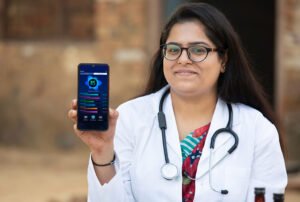
Since the use of telehealth, or remotely accessed medical care, has grown during the pandemic, an engaged network of healthcare advocates is seeking to expand coverage to underserved communities with the launch of the Telehealth Equity Coalition (TEC).
Launched this month, the TEC aims to unite nonprofit, academic, and industry partners to promote equitable access to telemedicine. This includes, according to its website, addressing issues such as limited access to broadband and hardware, along with promoting digital and health literacy.
The group’s launch was announced February 2nd at the virtual ATA EDGE Policy Conference by the American Telemedicine Association (ATA), the National Health IT Collaborative for the Underserved (NHIT), and the wellness company Hims & Hers. The coalition’s member organizations include the Health Innovation Alliance, American Psychological Association, Howard University’s Department of Community and Family Medicine, and BlackDoctor.org.
As NPQ has covered, amid COVID-19, reliance on telehealth has increased across the medical system, especially mental health care. However, telehealth remains in a state of flux. Prior to the pandemic, usage was low, according to the Kaiser Family Foundation. Since then, however, “the federal government has focused on broadening telemedicine access for Medicare beneficiaries, and waiving enforcement of HIPAA (the Health Insurance Portability and Accountability Act) to enable the use of video platforms like FaceTime and Skype. Many states have relaxed telemedicine written consent, licensing, and online prescribing laws, while expanding coverage in Medicaid and fully insured private plans.”
Among the group’s goals is making sure telehealth remains covered by Medicare and Medicaid once the pandemic subsides. As Dr. Joseph C. Kvedar, chair of the ATA board, says in the group’s press release, “It is clearly time to make telehealth a legitimate care delivery channel for the long haul by tackling policy, reimbursement, and implementation challenges, and resolving health disparities that have long plagued our healthcare system.”
Sign up for our free newsletters
Subscribe to NPQ's newsletters to have our top stories delivered directly to your inbox.
By signing up, you agree to our privacy policy and terms of use, and to receive messages from NPQ and our partners.
The coalition’s focus matches the telehealth expansion proposed in a recent report by the Centers for Disease Control and Prevention (CDC), which noted that 30.2 percent of healthcare visits between June 26 and November 6 of last year took place via telehealth. Even with the COVID-19 Public Health Emergency proclamation and the subsequent expansion of telehealth, the report also shows that Southern census regions and rural regions continue to lag behind, with lack of broadband access being one significant cause for the reported disparities.
Telehealth certainly can help expand healthcare access, but as a recent study by the RAND Corporation details, not all telehealth visits are alike. The Rand study of 500 health clinics in California found that many telehealth visits, especially for low-income patients, were by audio only, raising serious questions about care quality.
“Lower-income patients may face unique barriers to accessing video visits, while federally qualified health centers may lack resources to develop the necessary infrastructure to conduct video telehealth,” says Lori Uscher-Pines, a senior policy researcher at RAND, in a press release. “These are important considerations for policymakers if telehealth continues to be widely embraced in the future.”
Fabiola Carrión, senior attorney at the National Health Law Program’s Los Angeles offices, writes on the organization’s website, “Medicaid enrollees and low-income populations should have access to devices that enable a telehealth interaction.” But equitable telehealth means not just increased access to devices, but training, too—a reminder to develop person-centered approaches. Even some individuals with access to computers do not know how to use them properly; these access issues disproportionately affect elderly, Black, and/or Latinx patients, as well as those with less education. Digital literacy is critical for providers and staff, too, as is the availability of language interpreters when telehealth services are provided.
Still, despite the challenges, telehealth seems to be here to stay, so ensuring equitable access to its benefits is imperative. As Mark Rank, author of a new book on US poverty and professor of social welfare at the Brown School at Washington University in St. Louis, says in Futurity, “Very few of us are immune from the reach of poverty at some point. This understanding can shift our perceptions of the poor.” It can also be a roadmap to a healthier future.—Nicole Zerillo












